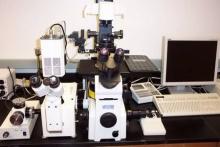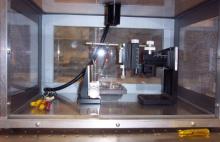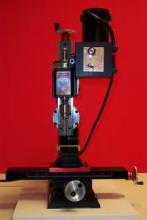The Gratzl/Biomedical Sensing Laboratory is housed in the Wickenden Building (Department of Biomedical Engineering, CWRU). It includes five adjacent laboratory rooms. One of them has lab benches enough for 12 people working simultaneously (about 1,500 sq ft), and is equipped with all usual wet lab accessories (hood, sinks, refrigerator, cabinets, storage space for different chemicals, water still, etc). The lab has the capabilities to perform highly sensitive single cell level experiments using micro-electrodes and BioMEMS platforms. A CHI1030 multichannel potentiostat (CH Instruments, Inc.) is available for electrochemical detection of physiologically important chemical species. The lab has also recently purchased and new CHI1030 potentiostat with a 64 channel multiplexer, capable of performing 64 independent single cell experiments simultaneously.
The lab equipment also comprises standard laboratory glassware, gas flowmeters, ultrasonic cleaning device, analytical balances (Mettler and Fisher), Accumet pH meter (Fisher), hood for hazardous chemicals and waste storage, and place for gas tanks and pipelines for gases. Equipment for all existing electrochemical techniques (BAS, CH Instruments) and a potentiostat for very small currents (Axopatch with Patch clamp) are also available.
State of the equipment for performing optical microscopy comprises of Nikon model TE2000-U inverted microscope system with Metamorph software, Nikon 5000d digital camera; a 182 nm excimer laser (Lambda Physik); a dual detector S2000-FL spectrometer with fluorescence detection system (World Precision Instruments); Nikon Diaphot and stereo microscopes, a computer based reflectance microscope with up to 100x magnification and zooming capability. Spectrophotometers for optical measurements which comprises a solid state diode array detector for dynamic spectral recordings and a flexible optics-based optical system with absorbance and fluorescence measurement capabilities is one of the latest addition to the laboratory equipment.




